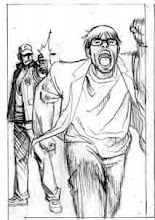Reader identification
Dynamic motion versus static images
The Flash exemplifies comic book's energetic potential
Artistic expression of speed
i.e. Speed lines, blurred images, forced perspective
Flying, put them in the clouds
All-American Publications
Flash Comics # 1 (Jan. 1940)
Hard water fumes or "heavy" water vapors
College student
Father's WWI helmet redesigned as Hermes
Hawkman, Black Canary
All Star Comics (summer 1940)
Two DC Comics (Adventure & More Fun)
Two All-American (All-American & Flash)
Sandman, Hour-Man, Green Lantern, The Atom, Hawkman, Johnny Thunder,
Spectre, and Dr. Fate.
All Star Comics #3
Introduction of the Justice Society of America
All Star Comics #4 (March-April 1941)
Poll results pick Flash for solo title
All-Flash Quarterly
"Honorary" status in JSA due to editorial policy
Comic Calvacade (Winter 1943)
Flash, Wonder Woman, Green Lantern
All Star Comics #24 (Spring 1945)
Flash returns to JSA
Series canceled at #57 (Feb/March 1951)
Four titles in Golden Age.
Most believeably written of superheroes.
Jay Garrick fought gangsters, kidnappers, racketeers, corrupt politicians, swindlers, and frauds.
Humiliation and tormenting his opponents.
Vibrating superfast he could become invisible and haunt the criminals "ghost-like".
Throwing pies and forcefeeding criminals.
Mischievous streak.
Supervillains.
The Fiddler, the Thinker, the Thorn, the Shade
Usually a villain initially triumphs before the hero discovers how to turn the tables. Jay Garrick's conflicts, however, were remarkably unchallenging, and the entertainment value of such stories relied upon the reader enjoying the villains being toyed with unmercifully before they surrendered - or in some cases, before they saw the error of their ways and reformed.
Post WWII costumed characters fell out of favor.
All-Flash cancelled with issue #32 (Dec./Jan. 1947) and the last issue of Flash comics was #104 (Feb. 1949). After Comic Calvacade #29 (Oct./Nov. 1948) became a funny animal book.
Ten years after his final JSA adventure Jay returned to DC Continuity with The Flash #123 (Sept. 1961). Gardner Fox.
The "multiverse" concept.
All-American Comics
225 Lafayette St.
Harry Lampert, artist
Gardner Fox, writer
M.C. Gaines, boss
Shelly Mayer, editor
Gaines & Mayer pulled Superman from DC slush pile. Within 18 months
Flash was third superhero to garner a second title.
Superman
Strong, invulnerable, alien
Batman
Escape artist, detective, human
Flash
Fast, scientist, superhuman
Flash Comics #1
Jay Garrick, college student, tries to get Joan, but his football skills don't impress her. Studying gases from "hard water", he separates the elements, and while taking a smoke break late night, he is too slow to catch the broken beakers. Professor Hughes finds him in the morning after he has inhaled all the fumes. After weeks in the hospital, he finally recovers and then some. Chasing after Joan, Jay realizes his speed, compared to a hurricane, a wind, a ghost. He gets books superfast for Joan from the library, who then decides to go with him to the dance if he uses his speed to play in the state game. Benched most of the game, a star player getting taken out puts Jay in the game. Leadfoot Garrick scores touchdown after touchdown, becoming a football hero. After graduation Jay heads to New York for Assistant Professorship at Coleman University. Reading in the newspaper about racketeers, Jay becomes the Flash and confronts them, never actually seen in a panel, but mentioned in the next. He feels a sense of purpose. Playing tennis against himself, no regard for secret identity, Joan recognizes Jay's powers. Her father was kidnapped, the thugs drive by shoot at Joan, but Jay catches the bullet. Sieur Satan, Serge Orloff, Duriel, all concoct a plan to find out the secret base of the atmoic bombarder. The villains keep him in a room made of mirrors, which he says are stealing his mind. They then try to get Joan's body to show him they mean business to get him to talk, the Faultless Four. Joan tells Jay of their threats to find out the secret. The Flash then charges after the car following it to the hideout. An explanation of his powers, catching a bullet, rescues Joan's father, then speeds back to listen in on the four's plans. They attach Coney Island Beach with a machine gun from a plane. Satan kills his cohorts trying to fry the Flash with an electrified room, but he speeds out. Satan tries to escape by his car but crashes.
Hard water or heavy water stops cell division, causes infertility, more dense.
Placing females on a pedestal.
Joan Williams, more than just a girlfriend, a partner, helpmate, a confidante, and a force to be reckoned with. Mayer looked at men and woman as equals.
Humor, Three Dimwits.
Flash #123 Flash of Two Worlds
Jay as comic book character
Inspiring Barry to name himself the Flash
Jay's villain Rival
Hero worship
The genius of the parallel world concept was that it promised so much more. Throughout the 1970's, more prominent alternate Earths were developed, each offering unique viewpoints and glimpses of a veritable multiverse that's begun to flower anew in 21st century DC comics.
"Elseworlds"
Doralla Kon "Lady Flash"
Flash #145 & #157

No comments:
Post a Comment